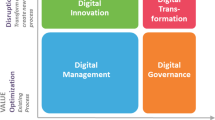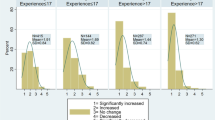Abstract
Multi-campus universities are not a new phenomenon per se, but they have become an increasing feature of contemporary higher education systems all over the world. In the case of Northern Europe, multi-campus universities are the consequence of contraction patterns resulting from overcapacity, fragmentation and rising competition. This paper has two main objectives. First, to take stock of the existing scientific literature on multi-campus universities and, on that basis, develop a novel conceptual framework for categorizing such systems, with focus on the level of autonomy and profile enjoyed by the individual campuses composing a given system or university. Second, we provide new empirical insights as a way of testing and contextualizing our conceptual model, by drawing upon a case university located in the Nordic countries.
Similar content being viewed by others
References
Becher, T., & Trowler, P. (2001). Academic tribes and territories: Intellectual enquiry and the culture of disciplines. Buckingham: Open University Press.
Bianchi, M. (1999). Multicampus model and quality approach in the institution of big universities. Paper presented at Tertiary Quality Management for Higher Education Institutions II conference, University of Verona, 30–31 August.
Boxenbaum, E., & Jonsson, S. (2008). Isomorphism, diffusion and decoupling. In R. Greenwood, C. Oliver, K. Sahlin, & R. Suddaby (Eds.), The Sage handbook of organizational institutionalism (pp. 78–98). London: Sage.
Clark, B. R. (1983). The higher education system: Academic organization in cross-national perspective. Los Angeles: University of California Press.
Clark, B. R. (1998). Creating entrepreneurial universities: Organizational pathways of transformation. New York, NY: Pergamon.
Creswell, J., Roskens, R., & Henry, T. (1985). A typology of multicampus systems. The Journal of Higher Education, 56, 26–37.
de Boer, H., & Goedegebuure, L. (2009). The changing nature of the academic deanship. Leadership, 5, 347–364.
DiMaggio, P. (1991). Constructing an organizational field as a professional project: US art museums, 1920–1940. In W. W. Powell & P. DiMaggio (Eds.), The new institutionalism in organizational analysis (pp. 267–292). Chicago, IL: University of Chicago Press.
Ewers, P. (2000). Governance for a multi-campus university. Report to Roosevelt University (Unpublished). Chicago, IL: Roosevelt University.
Fumasoli, T., Pinheiro, R., & Stensaker, B. (2015). Handling uncertainty of strategic ambitions — The use of organizational identity as a risk-reducing device. International Journal of Public Administration, 38, 1030–1040.
Johnstone, D. B. (1999). Management and leadership challenges of multicampus systems. In J. Gaither (Ed.), The multicampus system: Perspectives on practice and prospects (pp. 3–20). Sterling, VA: Stylus Press.
Johnstone, D. B. (2012). Higher educational autonomy and the apportionment of authority among state governments, public multi-campus systems, and member colleges and universities. Paper prepared for the SUNY Critical Issues in Higher Education conference, harnessing systems, delivering performance November 8–9, New York.
Jongbloed, B., Enders, J., & Salerno, C. (2008). Higher education and its communities: Interconnections, interdependencies and a research agenda. Higher Education, 56, 303–324.
Kavanagh, M., & Taysom, S. (1999). Multicampus university in operation: Perceptions of staff and students. Journal of Institutional Research in Australasia, 8, 98–108.
Kerr, C. (2001). The uses of the university (5th ed.). Cambridge, MA: Harvard University Press.
Kyvik, S. (2007). Academic drift: A reinterpretation. In J. Enders & F. van Vught (Eds.), Towards a cartography of higher education policy change: A Festschrift in Honour of Guy Neave (pp. 333–338). Enschede: Center for Higher Education Policy Studies.
Lee, E., & Bowen, F. (1971). The multicampus university: A study of academic governance. New York, NY: McGraw-Hill.
Leihy, P., & Salazar, J. (2012). Institutional, regional and market identity in Chilean public regional universities. In R. Pinheiro, P. Benneworth, & G. A. Jones (Eds.), Universities and regional development: A critical assessment of tensions and contradictions (pp. 141–160). New York, NY: Routledge.
McGuinness, A. (1996). A model for successful restructuring. In M. Taggart (Ed.), Restructuring higher education: What works and what doesn’t in reorganizing governing systems (pp. 203–229). San Francisco, CA: Jossey-Bass.
Nel, H. (2006). Planning to thrive: A case study of multi-campus management in a South African comprehensive university. Paper presented at the Tertiary Education Management Conference (TEM), Sydney, 28–30 August.
Nicolson, R. (2004). The management of multicampus systems. South African Journal of Higher Education, 18, 346–358.
NMMU. (2012). Re-alignment of governance system to strengthen ties between NMMU’s George campus and faculties. Press release, 17 July. Nelson Mandela Metropolitan. Retrieved from: https://doi.org/www.georgecampus.nmmu.ac.za/News/Re-alignment-of-governance-system-to-strengthen-ti
Norgård, J. D., & Skodvin, O. J. (2002). The importance of geography and culture in mergers: A Norwegian institutional case study. Higher Education, 44, 73–90.
Oliver, C. (1992). The antecedents of deinstitutionalization. Organization Studies, 13, 563–588.
Pache, A.-C., & Santos, F. (2013). Inside the hybrid organization: Selective coupling as a response to competing institutional logics. Academy of Management Journal, 56, 972–1001.
Pierson, P., & Skocpol, T. (2002). Historical institutionalism in contemporary political science. In I. Katznelson & H. Milne (Eds.), Political science the state of the discipline (pp. 693–721). New York, NY: W. W. Norton.
Pinheiro, R. (2012a). In the region, for the region? A comparative study of the institutionalization of the regional mission of universities. Oslo: University of Oslo.
Pinheiro, R. (2012b). University ambiguity and institutionalization: A tale of three regions. In R. Pinheiro, P. Benneworth, & G. A. Jones (Eds.), Universities and regional development: A critical assessment of tensions and contradictions (pp. 35–55). New York, NY: Routledge.
Pinheiro, R., Benneworth, P., & Jones, G. A. (2012). Understanding regions and the institutionalization of universities. In R. Pinheiro, P. Benneworth, & G. A. Jones (Eds.), Universities and regional development: An assessment of fensions and contradictions (pp. 11–32). New York, NY: Routledge.
Pinheiro, R., Charles, D., & Jones, G. (2015, online first). Equity, institutional diversity and regional development: A cross-country comparison. Higher Education, 1–16. https://doi.org/www.link.springer.com/article/10.1007/sl0734-015-9958-7.
Pinheiro, R., Geschwind, L., & Aarrevaara, T. (2014). Nested tensions and interwoven dilemmas in higher education: The view from the Nordic countries. Cambridge Journal of Regions, Economy and Society, 7, 233–250.
Pinheiro, R., Geschwind, L., & Aarrevaara, T. (2016). Mergers in higher education: The experiences from Northern Europe. Dordrecht: Springer.
Pinheiro, R., & Stensaker, B. (2014a). Designing the entrepreneurial university: The interpretation of a global idea. Public Organization Review, 14, 497–516.
Pinheiro, R., & Stensaker, B. (2014b). Strategic actor-hood and internal transformation: The rise of the quadruple-helix university? In J. Brankovik, M. Klemencik, P. Lazetic, & P. Zgaga (Eds.), Global challenges, local responses in higher education. The contemporary issues in national and comparative perspective (pp. 171–189). Rotterdam: Sense Publisher.
Room, G. (2011). Complexity, institutions and public policy: Agile decision-making in a turbulent world. Cheltenham: Edward Elgar.
Satya, P., & Lodewijks, J. (2003). Alternative structures and teaching modes for a multi-campus university. Economic Analysis and Policy, 33, 136–144.
Schmidtlein, F., & Berdahl, R. (2005). Autonomy and accountability: Who controls academe? In P. Altbach, R. Berdahl, & P. Gumport (Eds.), American higher education in the twenty-first century: Social, political, and economic challenges (pp. 71–90). Baltimore, MD: Johns Hopkins University Press.
Scott, G., Grebennikov, L., & Johnston, K. (2007). Study of Australian multi-campus universities. Journal of Institutional Research, 13(1), 1–23.
Selznick, P. (1984). Leadership in administration: A sociological interpretation. Berkeley: University of California Press.
Selznick, P. (1996). Institutionalism “old” and “new”. Administrative Science Quarterly, 41, 270–277.
Skodvin, O. J. (1999). Mergers in higher education-success or failure? Tertiary Education and Management, 5, 63–78.
Stensaker, B., Larsen, I. M., & Kyvik, S. (2005). Noen erfaringer og utfordringer med fusjoner i høyere utdanning: Et diskusjonsnotat utarbeidet i forbindelse med sammenslåingen av Høgskolen i Lillehammer og Høgskolen i Gjøvik[Some experiences and challenges with mergers in higher education: A discussion paper prepared in connection with the merger of Lillehammer University College and Gjøvik University College]. Arbeidsnotat 24/2005. Oslo: NIFU-STEP.
Szutz, J. J. (1999). Higher education systems and strategic planning. In G. Gaither (Ed.), The mul-ticampus system: Perspectives on practice and prospects (pp. 82–97). Sterling, VA: Stylus Publishing.
Whitley, R. (2008). Constructing universities as strategic actors: Limitations and variations. In L. Engwall & D. Weaire (Eds.), The university in the market (pp. 23–37). London: Portland Press Ltd.
Winchester, H., & Sterk, B. (2006). Multi-campus university management: Lessons from AUQA audit reports. MelbourneAUQA Occasional Publications, no. 7, 164–170.
Yin, R. K. (2014). Case study research: Design and methods. London: Sage.
Zechlin, L. (2010). Strategic planning in higher education. In P. Peterson, E. Baker, & B. McGaw (Eds.), International encyclopedia of education (pp. 256–263). Amsterdam: Elsevier.
Author information
Authors and Affiliations
Corresponding author
Rights and permissions
About this article
Cite this article
Pinheiro, R., Berg, L.N. Categorizing and assessing multi-campus universities in contemporary higher education. Tert Educ Manag 23, 5–22 (2017). https://doi.org/10.1080/13583883.2016.1205124
Received:
Accepted:
Published:
Issue Date:
DOI: https://doi.org/10.1080/13583883.2016.1205124




